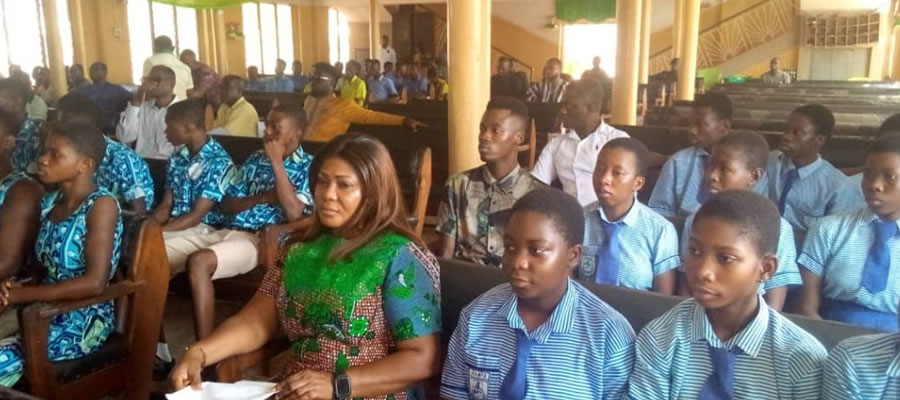

Key Decentralized Departments in the District
The Adansi South District had not got the full complement of decentralized departments. The following departments exist to carry out specialized functions.
Department of Social Welfare and Community Development
Ghana National Fire Service
Forestry Services Division
District Education Service
District Health Service
District Ambulance Service
CHRAJ
National Commission for Civic Education
Electoral Commission
Department of Agriculture
Environmental Health Department
National Disaster Management Organization
Department of Co-operatives
Non-Formal Education Division
Births and Deaths
Ghana Water Company
Physical Planning Department
Information Services Department
Stool Lands
Non-Governmental Organisations (NGOs)
The following NGOs with their respective functions operate in the District.
Land Tenure System
The system of land Tenure prevalent in the District is principally the “Abunu” and “Abusa” systems. Whereas in the case of “Abunu”, the farmer shares his produce equally with the land owner or Lander, in the case of the “Abusa”, the land owner takes two-thirds of the farm produce. This system does not serve as motivation for increase productivity on the part of the farmers.
In some instances, the land owner dictates the types of crops to be produced irrespective of the suitability of the land to the crop in question. One possible advantage of the system is the permanence of land holding, settler farmers are allowed to hold their farms for a long period of time, creating a situation of security and permanent settlement in areas like Tweapease, Nkrankese and Menang.
Disaster
The Adansi South District has six disaster management zones namely, Asokwa, Fumso, Praso, Apagya, Akutreso and New Edubiase. Each zone is being manned by two (2) Zonal Coordinators. A District Co-coordinator and two supporting members of staff head the District office. With respect to disaster management at the District level, two main committees are responsible for major management decisions. The committees are District Disaster technical committee and District Disaster management committee.
Though some zones are now under Adansi North District but since the District has no coordinator, zones like Fumso and Asokwa are still under the management of Adansi South District.
Rain/Wind Storm
This is one of the most recurring disasters in the District. For instance, between January and December 2005, the District recorded (20) cases in (20) communities namely Birim Aboye, Akroso, Aboabo III etc. The damage caused to personal and physical property of the victims and their dependants runs into several millions of Cedis. The basic cause of this disaster is the absence of trees to serve as wind breaks in the communities.
Floods
Flooding in its sense has not been recorded in the District some time now. What the District normally experienced have been pools of stagnant water witnessed after any heavy rainfall in the communities. Though personal property destroyed in times like this are minimal, the damage done to the buildings cannot be under estimated. Indiscriminate situating of physical structures, the nature of the soil and refuse dumps are responsible for this.
Domestic Fire
In the year 2002, 2004/2005 seventeen cases were recorded with estimated cost of ¢850,000,000.00. Four cases were received from Adansi Kenya, Edwinase, Obonsu, Anhwiaso, Nyankomase, Akrofuom and Amudurase. The number of cases in this disaster seems insignificant but the cost of damage to personal property was very high. It was only at Amudurase where one of the fire fighters sustained slight burns on the left arm. These cases also came about through indiscriminate handling of marked flames.
Natural/Bush Fire
Each year, between January and April, bush fire becomes rampant due to the start of new farming season. The hills opposite Nyankomase are engulfed in smoke leading to fire-outbreak, which destroy farms and other flora. The actual cause is not yet scientifically known. But it has been widely explained that the fire emanates from the rocks on the hill, which sparkle when rolling stones rub one another.
Bush fires caused by individuals have been on the low side. For instance, only three incidences were recorded at Praso, Edwinase, and Adansi Kenya in 2010. This could be attributed to the intensive educational campaign made by NADMO in conjunction with the National Fire Service.
Chain Saw Operation
Indiscriminate logging and the unethical use of machines have caused substantial damage to the vegetation in the District. Efforts made to discourage this activity have not been very effective as a result, several wood felted are not cart and therefore, remain at the mercy of termites.
Drought
Many rivers and streams in the District dry up few weeks after the rainy season. This is because falling of trees, especially along river courses and on mountains, continues to be a major problem in the District. Water therefore becomes very scarce for both domestic and on-farm activities during greater part of the year.
Conflict
As far as conflict is concerned, the District is among the most peaceful Districts in the country, though it is predominantly multi-tribal residence. The most conspicuous hazard in the District is the impasse between stool land lords and the tenant settler farmers on the payment of annual land tribute. There have been occasional isolated cases of conflict between individuals or small groups. The complaints and Arbitration sub-committee of the Assembly or by the NADMO Technical committee however, dispose-off these cases peacefully.
Date Created : 11/10/2017 6:30:09 AM










 facebook
facebook
 twitter
twitter
 Youtube
Youtube
 +233 593 831 280
+233 593 831 280 0800 430 430
0800 430 430 GPS: GE-231-4383
GPS: GE-231-4383 info@ghanadistricts.com
info@ghanadistricts.com Box GP1044, Accra, Ghana
Box GP1044, Accra, Ghana